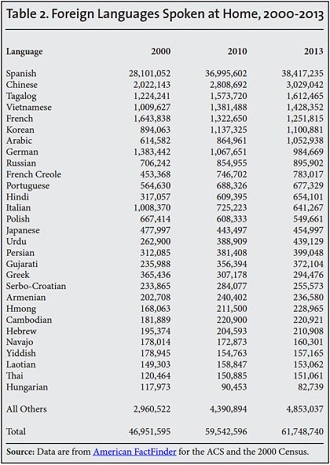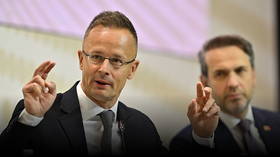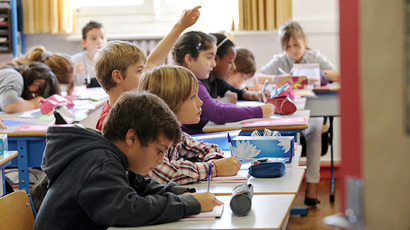Record 61.8 mn US residents don’t speak English at home

English is not the spoken language in a record 20 percent of American homes, a study has found. Arabic and Urdu ‒ Pakistan’s national language ‒ are the fastest-growing languages spoken in US houses, according to the Center for Immigration Studies (CIS).
CIS revealed data parsed from the United States Census Bureau’s 2013 American Community Survey (ACS), which was released last month. The ACS is a mandatory, ongoing statistical survey which the US government uses to give communities the current information they need to plan investments and services, according to the Census Bureau website.
The non-profit research organization focused on the part of the survey that looked at languages spoken by those five years of age and older. The three relevant questions on the ACS look at whether a language other than English is spoken in the home, what language that is, and how well each person canvassed speaks English.
In 2013, a record 61.8 million US residents (native-born, legal immigrants, and illegal immigrants) spoke a language other than English at home – an increase of 2.2 million from 2010, the survey found. That number has grown by nearly 15 million since 2000 and by almost 30 million since 1990.
Of the 27 million native-born residents who speak a language other than English at home, 9.9 million (36 percent) are 17 and under. The remaining 64 percent were born in the United States and are adults who speak a language other than English at home.

The most common non-English language is Spanish, with 38.4 million speakers, followed by Chinese (3 million speakers), Tagalog (1.6 million), Vietnamese (1.4 million), and French (1.25 million). Korean and Arabic also have over a million speakers. The fastest growing languages are Spanish (up 1.4 million, 4 percent growth), Chinese (up 220,000, 8 percent growth), Arabic (up 188,000, 22 percent growth), and Urdu (up 50,000, 13 percent growth).
While the background report itself takes no opinion on the data, CIS is a nonpartisan, yet politically conservative organization that advocates immigration reduction in the United States. It says its mission is “providing immigration policymakers, the academic community, news media, and concerned citizens with reliable information about the social, economic, environmental, security, and fiscal consequences of legal and illegal immigration into the United States,” according to its website.
Steven Camarota, CIS’ director of research and one of the co-authors of the report, told the Washington Times that the increase in foreign language speakers isn’t an accident, but rather the result of policy decisions that could be reversed by Congress.
“Allowing in over one million new legal immigrants a year and to a lesser extent tolerating illegal immigration has important implications for preserving a common language,” Camarota said. “For too long, we have given little consideration to whether continuing this level of immigration, mostly legal, hinders the assimilation of immigrants and their children.”
Over 40 percent of those surveyed ‒ 25.1 million ‒ indicated that they speak English at some level that is less than “very well.” The lack of fluency can strain government resources, especially at the local level. With an influx of unaccompanied minor children illegally crossing the border from Central America during the first half of 2014, many school systems are facing overcrowding and underfunding with the increasing student population.
DeKalb County in Georgia reported 386 children placed with relatives or foster families in August alone – a 467 percent jump over the previous year’s total. Many of the immigrant children have special needs, including a complete lack of English language skills, and some have never been in school, according to the Washington Times.
The report also looked at the breakdown of languages by state. California led the nation with 15.7 million people ‒ 43.8 percent of the state’s population ‒ who spoke a language other than English in the home. Vermonters were the least likely to speak another tongue, with only 30,000 people ‒ or five percent of the population ‒ speaking something other than English at home.
California also has nearly three million school-aged children who speak a different language with their families, which is 44.6 percent of its student population. West Virginia has the smallest school-aged population speaking a different language, with 6,728 people – or 2.4 percent of those in that age range.
CIS noted that prior research by the Department of Homeland Security and others indicates that some 90 percent of illegal immigrants respond to the ACS.














